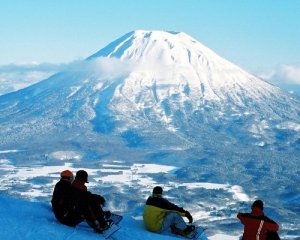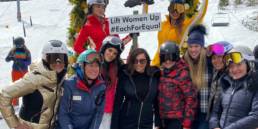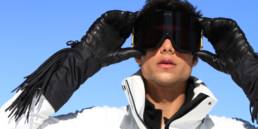Ancient traditions, unbeatable powder, and a healthy economy come together to form Niseko, a ski resort better enjoyed than contemplated.
by David K. Gibson
emailshare
Mid-afternoon on day five in Niseko, the cloud cover broke for about an hour. I gazed first at a tiny ring of crystalline blue sky, and watched it widen until it dropped to the eastern horizon. And there, taking up the whole of that horizon, was Mount Yotei. It was a perfect cone of volcanic glory, a mini-Fuji, so close and so massive and so storybook perfect that the experience was like discovering there was a walrus in my bathtub, and he’d been there for the better part of a week using my conditioner.

In that moment of clear sky, I had a moment of clarity. I grasped some pure truth about this mountain resort, its history and future, its clash of cultures, its destiny. And then the clouds rolled in, and the snow began to swirl, and I lost it all again in the powder.
What it is.
Niseko United is the name of the Hokkaido resort that people call “Niseko.” It is actually composed of four independently owned resorts, Niseko Grand Hirafu (Hanazono area), Niseko Grand Hirafu (Hirafu area),Niseko Village Ski Resort, and Niseko Annupuri. One pass gives access to all four areas, but they are only connected near the peak of the mountain, and then only by traverse when the snow pack is sufficient. Between the areas are steep gullies labeled “Strictly off limits” for very good reasons, so getting from one base area to the other must happen at the peak or by bus.
The mountain where all this happens isn’t called Niseko — that’s the name of a potato-farming village in the valley nearby — but Mount Annupuri, and it hosts, on other flanks and in adjoining valleys, an additional three resorts (if you count a ski-jump-only hill) that are not part of Niseko United. The slopes aren’t steep — somewhere between 30 and 40 degrees — but the silver birch trees form perfect glades.
At the base of the hill are three villages and an actual Japanese city. Beneath Annupuri is, fittingly, Annupuri, more a gathering of large private homes (some going for millions) than a true town, though it offers both lodging and dining options, some slope-side. At the foot of Niseko Village Ski Resort is the hotel-centric Niseko Village, though the name of the town was Higashiyama until the resort — in a triumph of marketing over history — renamed them both (locals, and the post office, still use the old name). Hirafu is the true ski town of the bunch, and sits at the base of the Grand Hirafu that shares its name — developmentally it sits somewhere between Crested Butte and Park City — and teems with bars, restaurants, and tourists. The other half of Hirafu, Hanazono, ends at a beautiful new day lodge and little else — at least for now. Nearby, should you want something like groceries or a crash course in actual Japanese culture, is Kutchan, the business hub of the area and a place where English and sign language will only get you so far.
Overlay this with maps printed by various business concerns that have conflicting views of the region’s physical reality, and it’s easy to miss the good stuff. So find a good concierge, and probably a driver.




